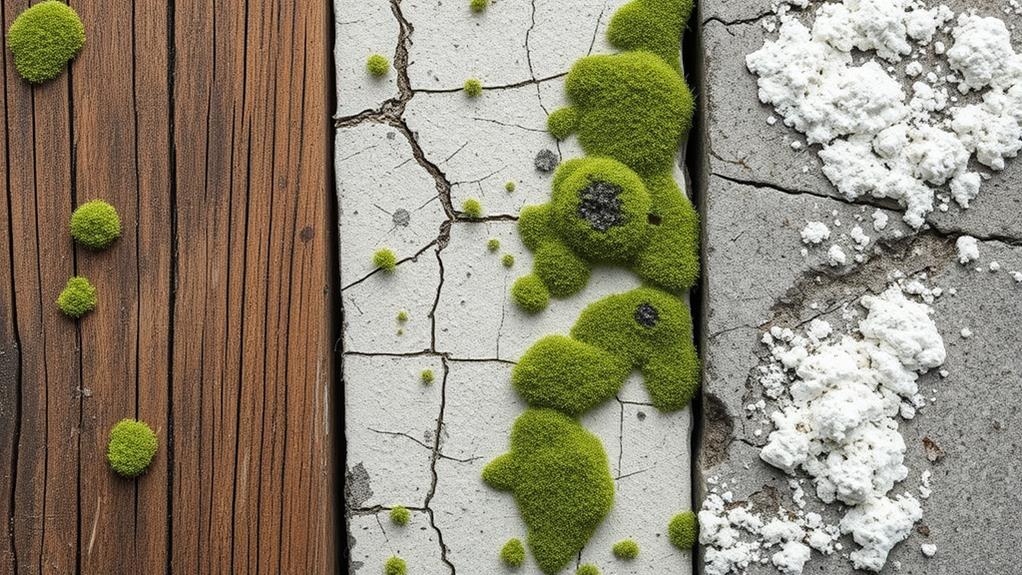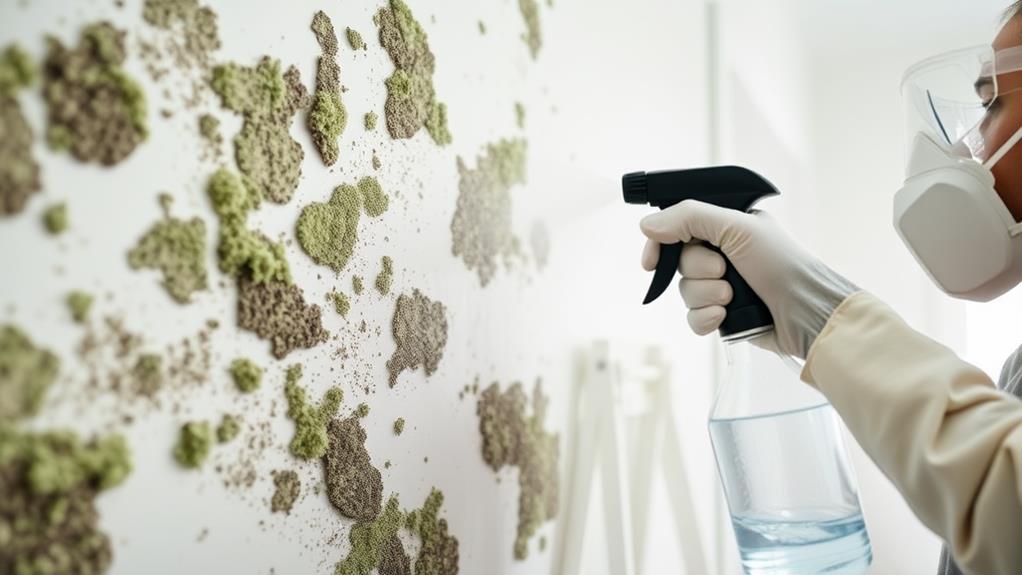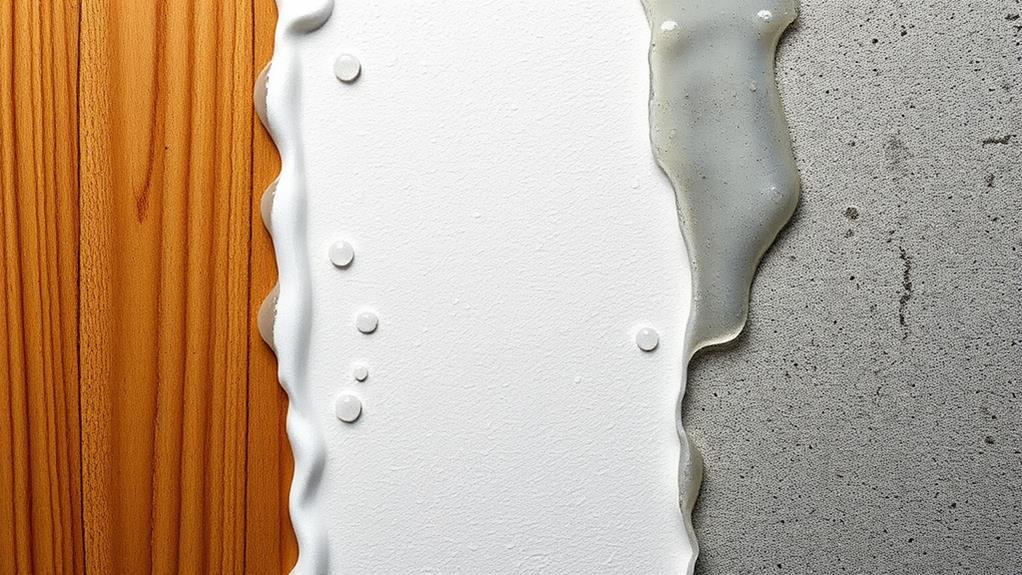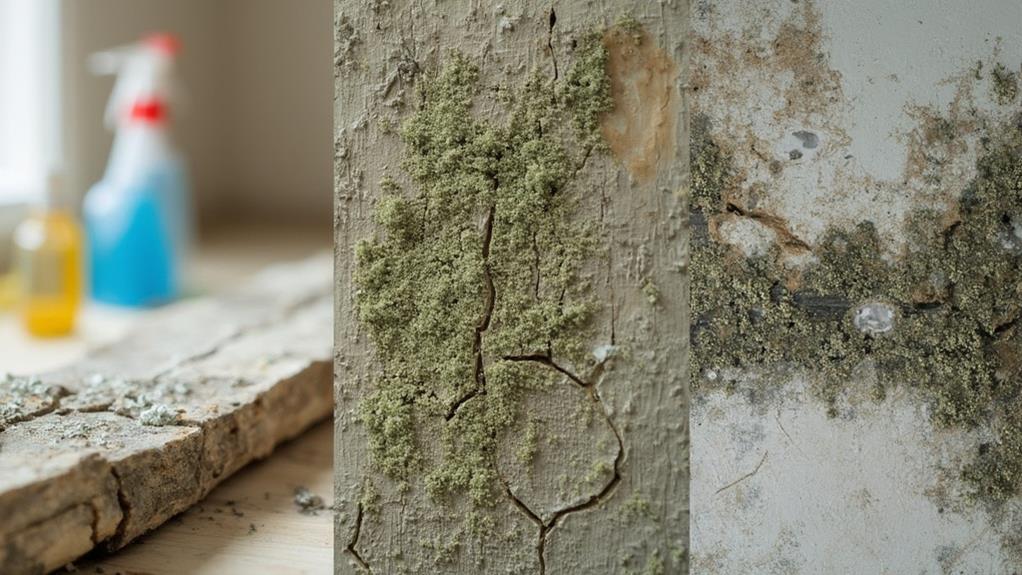Dealing with mold on wood, drywall, and concrete requires specific approaches for each surface. Wood's porous nature necessitates addressing moisture sources and using appropriate cleaning methods. Drywall infestations often spread rapidly, demanding quick action and potentially professional remediation for larger areas. Concrete mold issues involve surface cleaning and applying mold-resistant sealers. For all surfaces, prevention strategies include maintaining proper humidity levels, ensuring adequate ventilation, and promptly addressing water damage. Regular inspections and swift action are crucial for preventing mold growth. Understanding the unique challenges posed by each material is key to effectively managing household mold problems.
Identifying Common Household Molds

Several common types of mold can be found in households, each with distinct characteristics. Aspergillus, one of the most prevalent indoor molds, appears in various colors, including green, gray, and black. It often grows on damp walls, ceilings, and fabrics.
Penicillium, another frequent household mold, typically presents as blue or green patches on food items and in moist areas like bathrooms.
Stachybotrys, commonly known as black mold, is easily identifiable by its dark green or black color and slimy texture. It thrives in areas with high moisture levels, such as water-damaged drywall or wood. Alternaria, characterized by its velvety texture and dark green or brown color, is often found in damp areas like shower curtains and window frames.
Cladosporium, which can appear olive-green to brown or black, frequently grows on fabrics, wood surfaces, and in HVAC systems. Trichoderma, a fast-growing mold, is typically white with green patches and is commonly found on wet carpet, wallpaper, and other damp organic materials. Identifying these molds accurately is crucial for determining the appropriate remediation approach and preventing potential health risks associated with prolonged exposure.
Mold on Wooden Surfaces
Vulnerability to mold growth makes wooden surfaces a common target in many households. Wood's porous nature and ability to retain moisture create an ideal environment for mold spores to thrive. Common areas prone to wooden mold include window sills, door frames, baseboards, and furniture.
To address mold on wooden surfaces, first identify the moisture source and rectify it. Next, assess the extent of the damage. For small areas, a mixture of water and detergent can be effective. Gently scrub the affected area with a soft-bristled brush, then dry thoroughly.
For more stubborn mold, a solution of one part bleach to four parts water may be necessary. Always test cleaning solutions on an inconspicuous area first to prevent discoloration.
For extensive mold growth or if the wood has become soft or rotten, replacement may be the only option. To prevent future mold growth on wooden surfaces, maintain indoor humidity levels below 60%, use dehumidifiers in damp areas, and ensure proper ventilation. Regularly inspect wooden surfaces for signs of moisture or mold, and address any issues promptly to prevent further damage.
Treating Drywall Mold Infestations

Drywall mold infestations frequently occur in areas with high humidity or water damage. These infestations can spread rapidly, compromising indoor air quality and potentially causing health issues. To treat drywall mold, first identify and address the moisture source to prevent recurrence. For small affected areas (less than 10 square feet), homeowners can often handle the remediation themselves.
Begin by sealing off the affected area with plastic sheeting to prevent spore spread. Wear protective gear, including an N95 respirator, gloves, and goggles. Remove any wet or moldy materials, such as insulation or drywall, and dispose of them in sealed plastic bags. Clean the remaining surfaces with a detergent solution, then apply a disinfectant like diluted bleach or a commercial anti-fungal product.
For larger infestations or those involving toxic black mold, professional remediation is recommended. Experts use specialized equipment and techniques to safely remove mold and restore the affected area. In severe cases, entire sections of drywall may need replacement. After treatment, maintain proper ventilation and humidity control to prevent future mold growth. Regular inspections can help catch and address potential issues early.
Tackling Concrete Mold Issues
Concrete surfaces, despite their durability, can occasionally harbor mold growth, particularly in damp or poorly ventilated areas. Addressing mold on concrete requires a systematic approach to ensure effective removal and prevention of future infestations.
Begin by identifying the extent of the mold growth and addressing any underlying moisture issues. Improve ventilation and reduce humidity in the affected area to create an environment less conducive to mold growth.
For surface mold, a solution of water and detergent can be effective. Scrub the area thoroughly with a stiff brush, then rinse and dry completely.
For more stubborn mold, consider using a commercial mold cleaner or a mixture of one part bleach to four parts water. Apply the solution, allow it to sit for 15 minutes, then scrub and rinse. Always wear protective gear, including gloves, goggles, and a respirator mask, when dealing with mold.
After cleaning, apply a mold-resistant concrete sealer to help prevent future growth. For severe infestations or if the mold has penetrated deep into the concrete, professional remediation may be necessary to ensure complete eradication and to address any potential structural concerns.
Prevention Strategies for All Surfaces

While each surface type presents unique challenges when it comes to mold prevention, there are several universal strategies that can be applied across all materials. The key to preventing mold growth lies in controlling moisture and humidity levels. Maintain indoor relative humidity below 60%, ideally between 30-50%, using dehumidifiers or air conditioners as needed.
Ensure proper ventilation throughout your home, especially in areas prone to moisture accumulation like bathrooms, kitchens, and basements. Regularly inspect and repair any water leaks or damage promptly, addressing the source of moisture to prevent recurrence. Use mold-resistant products and materials when renovating or building, such as mold-resistant paints, drywall, and insulation.
Keep surfaces clean and dry, wiping up spills immediately and drying wet areas within 24-48 hours. Improve air circulation by using fans and opening windows when weather permits. Avoid storing organic materials in damp areas, as these can become food sources for mold. Lastly, conduct routine inspections of your property, paying close attention to hidden areas where mold may develop unnoticed, such as behind furniture or in crawl spaces.
Professional Remediation Options
When mold infestations become extensive or pose significant health risks, professional remediation services may be necessary. These experts employ specialized techniques and equipment to safely remove mold and prevent its recurrence.
Professional remediators typically begin with a thorough inspection and assessment of the affected areas, often using moisture meters and thermal imaging cameras to detect hidden mold growth.
For wood surfaces, professionals may use techniques such as sanding, media blasting, or chemical treatments to remove mold and restore the wood's integrity. Drywall remediation often involves cutting out and replacing affected sections, followed by proper sealing and refinishing. Concrete surfaces may require grinding, shotblasting, or the application of antimicrobial coatings to eliminate mold and prevent future growth.
In all cases, professionals prioritize containment to prevent mold spores from spreading to unaffected areas. They use negative air pressure systems, HEPA filtration, and proper disposal methods for contaminated materials. After remediation, professionals may conduct post-treatment testing to ensure the mold has been effectively eliminated and provide recommendations for ongoing prevention strategies tailored to the specific environment.
Frequently Asked Questions
Can Mold Grow on Painted Surfaces?
Yes, mold can grow on painted surfaces. Paint does not inherently prevent mold growth, especially if moisture is present. Mold can develop on painted walls, ceilings, or other surfaces when conditions are favorable for its growth.
How Quickly Does Mold Spread in a Home?
Mold spreads swiftly, silently, and stealthily in homes. Its growth rate depends on moisture levels, temperature, and available nutrients. Under ideal conditions, mold can colonize new areas within 24-48 hours and become visible within 1-2 weeks.
Are There Any Natural Remedies for Removing Mold?
Several natural remedies can effectively combat mold. White vinegar, tea tree oil, and baking soda are popular options. Hydrogen peroxide and grapefruit seed extract also work well. However, for severe infestations, professional treatment may be necessary to ensure complete removal.
Can Mold Return After Professional Remediation?
Yes, mold can return after professional remediation if underlying moisture issues are not addressed. Proper moisture control, ventilation, and regular maintenance are essential to prevent mold recurrence. Even with thorough removal, spores may remain dormant until conditions become favorable.
Does Homeowner's Insurance Typically Cover Mold Damage and Removal?
Like Pandora's box, homeowner's insurance coverage for mold can be complex. Typically, policies exclude mold damage unless it results from a covered peril. Some insurers offer limited mold coverage or riders for additional protection. Always review your policy carefully.
Conclusion
As the battle against household mold reaches its denouement, armed with knowledge and proper techniques, homeowners can emerge victorious. Like a skilled general, one must adapt strategies to conquer mold on various terrains—wood, drywall, and concrete. Vigilance is the fortress that guards against future invasions, while professional remediation serves as the ultimate reinforcement. With these tools in hand, the war on mold can be won, restoring homes to their former glory and safeguarding inhabitants' health.

